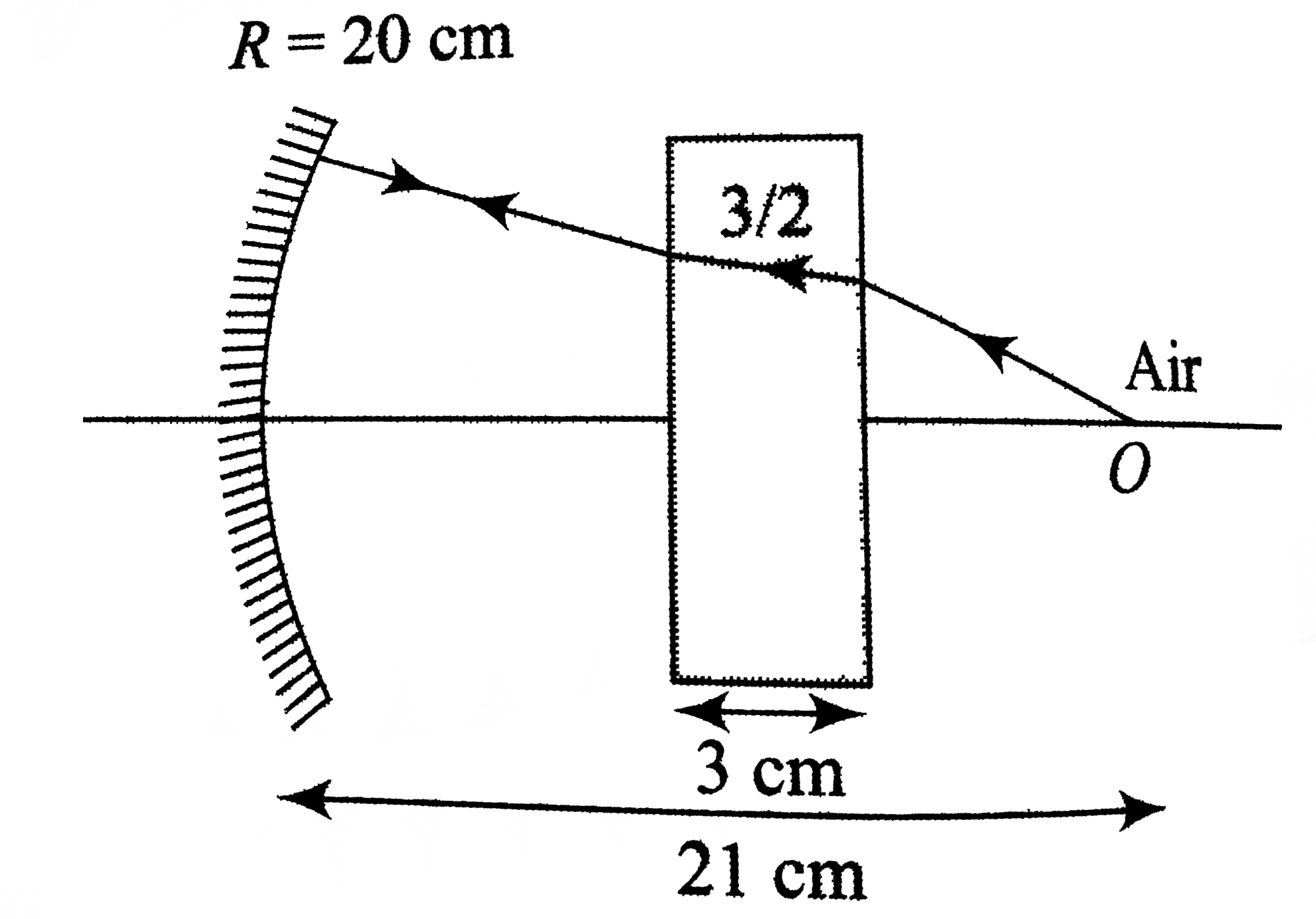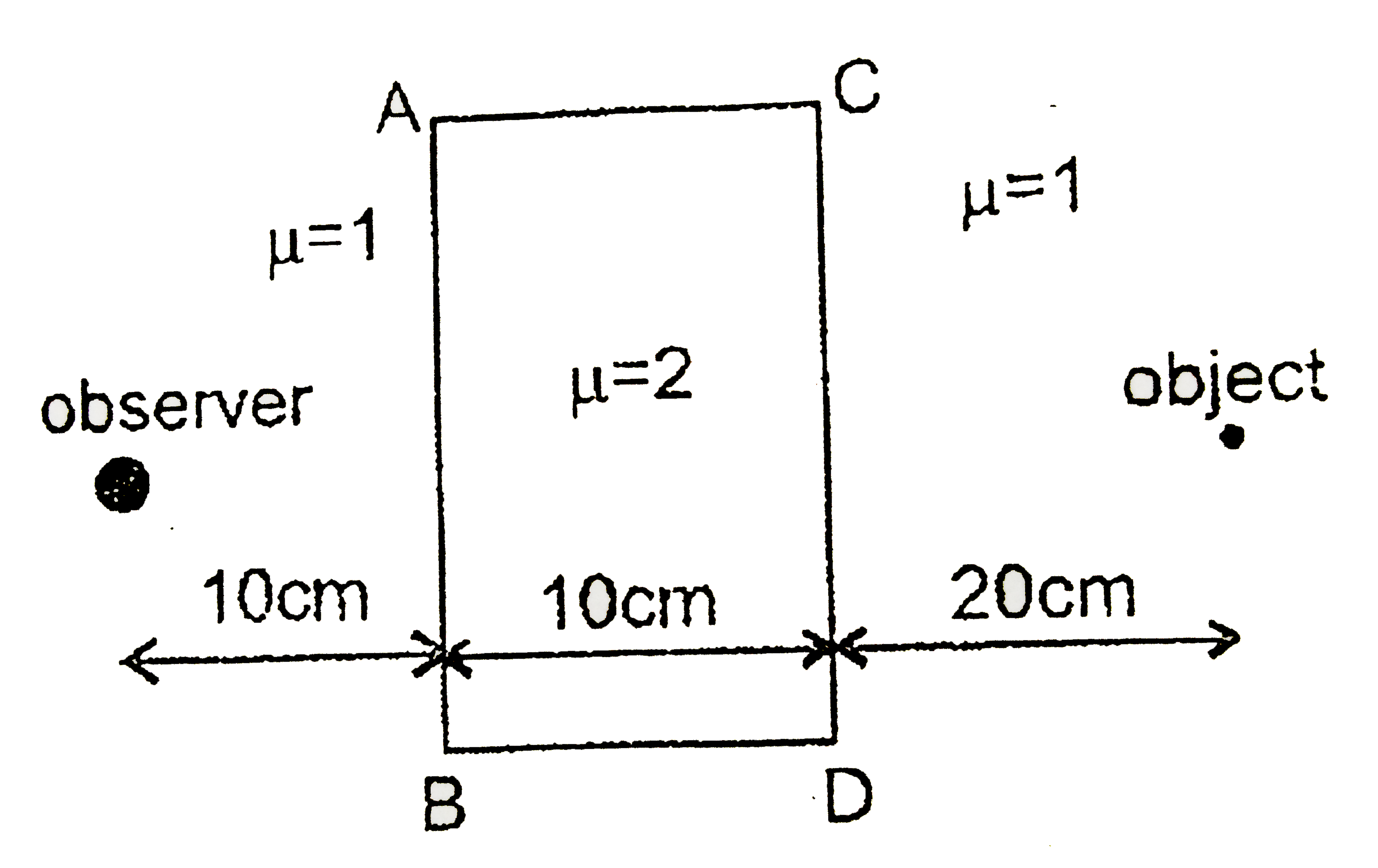An observer looks at an object kept at a distance 30 cm in air. If a rectangular glass plate (μ =1.5) is placed between the observer and the object with its thick-ness along the line of observation, the object appears to the observer to be at a distance 25 cm. Find the thickness of glass plate. Position of the glass plate is now shifted (i) from object towards observers (ii) from observer towards the object How does it change the apparent position of the object as seen by the observer?
To solve the problem, we need to find the thickness of the glass plate and analyze how shifting its position affects the apparent position of the object.
Step 1: Understand the Shift in Apparent Position
When the observer looks at the object through the glass plate, the object appears to be at a different distance due to the refraction of light. The apparent position of the object is given as 25 cm when the actual distance is 30 cm. The shift in the apparent position can be calculated as:
Shift(S)=Actual Distance−Apparent Distance=30cm−25cm=5cm
Step 2: Use the Formula for Shift
The formula for the shift caused by a slab of thickness t and refractive index μ is given by:
S=t(1−1μ)
Step 3: Substitute Known Values
We know that S=5cm and μ=1.5. We can substitute these values into the formula:
5=t(1−11.5)
Step 4: Simplify the Equation
Now, simplify the term 1−11.5:
1−11.5=1−23=13
Now substitute this back into the equation:
5=t(13)
Step 5: Solve for Thickness t
To find t, multiply both sides by 3:
t=5×3=15cm
Conclusion
The thickness of the glass plate is 15cm.
Step 6: Analyze the Effect of Shifting the Glass Plate
1. If the glass plate is shifted from the object towards the observer:
- The apparent position of the object will remain the same because the shift is dependent on the thickness of the slab and the refractive index, not the position of the slab. Thus, the object will still appear at 25 cm.
2. If the glass plate is shifted from the observer towards the object:
- Similarly, the apparent position of the object will remain unchanged at 25 cm for the same reason.
Summary
- Thickness of the glass plate: 15 cm
- Shifting the glass plate does not change the apparent position of the object; it remains at 25 cm regardless of whether the plate is moved towards the observer or the object.
When the observer looks at the object through the glass plate, the object appears to be at a different distance due to the refraction of light. The apparent position of the object is given as 25 cm when the actual distance is 30 cm. The shift in the apparent position can be calculated as:
The formula for the shift caused by a slab of thickness t and refractive index μ is given by:
We know that S=5cm and μ=1.5. We can substitute these values into the formula:
Now, simplify the term 1−11.5:
To find t, multiply both sides by 3:
The thickness of the glass plate is 15cm.
1. If the glass plate is shifted from the object towards the observer:
- The apparent position of the object will remain the same because the shift is dependent on the thickness of the slab and the refractive index, not the position of the slab. Thus, the object will still appear at 25 cm.
- Similarly, the apparent position of the object will remain unchanged at 25 cm for the same reason.
- Thickness of the glass plate: 15 cm
- Shifting the glass plate does not change the apparent position of the object; it remains at 25 cm regardless of whether the plate is moved towards the observer or the object.
Topper's Solved these Questions
- RAY OPTICS AND OPTICAL INSTRAUMENTS BOOK - NARAYNACHAPTER - RAY OPTICS AND OPTICAL INSTRAUMENTS EXERCISE - CUQ (REFLECTION)
9 Videos
- RAY OPTICS AND OPTICAL INSTRAUMENTS BOOK - NARAYNACHAPTER - RAY OPTICS AND OPTICAL INSTRAUMENTS EXERCISE - CUQ (REFRECTION)
28 Videos
- NUCLEI BOOK - NARAYNACHAPTER - NUCLEI EXERCISE - ASSERTION & REASON
5 Videos
- SEMI CONDUCTOR DEVICESBOOK - NARAYNACHAPTER - SEMI CONDUCTOR DEVICESEXERCISE - Level-II (H.W)
36 Videos
Similar Questions
Knowledge Check
An observer moves with a constant speed along the line joining two stationary objects. He will observe that the two objects
Ahave the same speedBhave the same velocityCmove in the same directionDmove in opposite directionsAn observer moves with a constant speed along the line joining two stationary objects. He will obserbe that the two objects
Ahave the same speedBhave the same velocityCmove in the same directionDmove in opposite directionOnc face of a rectangular glass plate 6 cm thick is silcerd. An object held 8 cm in front of the first face, froms an image 12 cm behind the silvered face. The refractive index of the glass is
A0.4B0.8C1.2D1.6
A point object is placed at a distance of 25cm from a convex lens. Its focal length is 22cm. A glass slab of refractive index 1.5 is inserted between the lens and the object, then the image is formed at infinity. Find the thickness of the glass slab (in cm).
View SolutionIf a convex lens of focal length 20 cm is held close to the eye of observer and the near point of the observer is 25 cm from the eye, find the distance of the object from the lens.
View SolutionAn object is placed on the principle axis of a concave mirror of focal length 10cm at a distance of 21cm from it. A glass slab is placed between the mirror and the object as shown in figure.
Find the distance of final image formed by the mirror.

View SolutionIn an ideal YDSE when a glass plate (μ=1.5) of thickness t is introduced in the path of one of the interfering beams the intensity at the position where the central maximum occured previously remains unchanged. The maximum thickness of the glass plate is:
View SolutionIf t is the real thickness μ is refractive index of a glass slab then the shift of the image with refernce to the object is given by
View Solution


